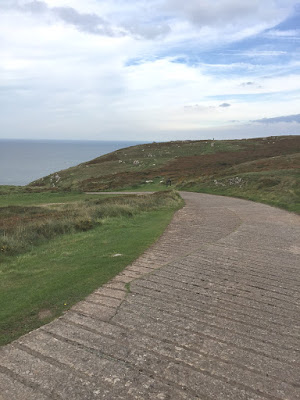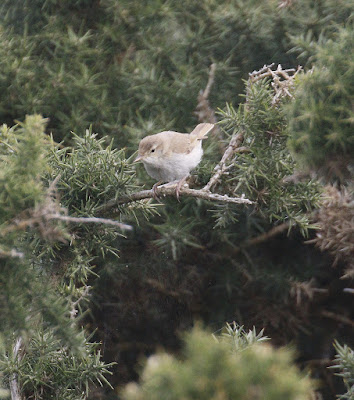Booted Warbler has long been on my radar as a bird I wanted to see and the opportunity arose this week with news of one, thousands of miles off course and frequenting gorse bushes at the top of Great Orme's Head above Llandudno in North Wales.
Booted Warblers breed from northwest, central and southern Russia east to western Siberia, northwest Mongolia and just into western China then extending south through Arabia, Iran, Afghanistan and probably Pakistan. Their normal wintering areas are the subtropical or tropical zones of Pakistan, central and southern India and Sri Lanka.
Booted Warblers have been the subject of much taxonomic study in recent times. It was for long considered to be in the same genus as Icterine and Melodious Warblers, namely Hippolais but the considerable advances in mitochondrial DNA analysis indicated that it should be assigned its own genus and it duly became Iduna caligata rather than Hippolais caligata. Not only that but its southern Asian populations were then examined and it was decided that they should no longer be considered a race of Booted Warbler but be elevated to full species level and they became Sykes's Warbler Iduna rama
I had been lucky enough to see a Sykes's Warbler on Fair Isle three years ago in 2013, so I was doubly keen to add its very close cousin the Booted Warbler to my list, having never seen one here or anywhere else in the world for that matter.
The two species are almost identical and it requires a considerable amount of careful and patient scrutiny to separate them, involving examination of subtle differences in plumage, structure, bill size and colour.
The Booted Warbler on Great Orme's Head when first discovered was publicised as either Booted or Sykes's Warbler as no one was quite sure of its true identity but an examination of photos determined it was a Booted Warbler which, given it breeds nearer to Britain than Sykes's was the more likely outcome.This was good news for me as now I had every chance to add this species to my list. Booted Warblers can tend to hang around for quite some time, often weeks when they do put in a rare appearance in Britain and I had already managed to miss seeing one on two occasions, a long staying individual in Scotland and another in Sussex, contriving in each case to go to see them the day after they left. Would this be third time lucky?
I consulted my RBA app at 8.00am and there was the welcome news that the Booted Warbler was still present on Great Orme's Head. The specific instructions given by RBA were:
Still Great Orme's Head in gorse at north end of limestone pavement car park. From Llandudno take Marine Drive then take concrete road on left beyond cafe and use lime stone pavement's car park.
It took just a few minutes to get my birding gear together and loaded into the car. I gave Clackers a quick call to see if he was up for a trip to North Wales.To my surprise he said yes so I collected him from his home in Witney and at 9am we set about getting through the rush hour traffic around Oxford. A cross country switchback across west Oxfordshire's rural roads finally got us onto the M40 and we commenced a three and a half hour drive in heavy but fast moving traffic. At this time of day on a weekday it was better to take the M6 Toll Road around Birmingham rather than the congested M6 and this definitely speeded our progress and after enduring an interminable 50mph average speed check near Manchester we turned off onto the M56 and headed past the huge chemical works at Runcorn, then into more pleasant rural surroundings along the North Wales Coast.
I had set the Satnav for Llandudno, planning to find Marine Drive once we got there and arriving on the outskirts of Llandudno, duly followed the signs for the Town Centre which seemed the logical thing to do. Llandudno from what we saw of it was a pleasant, busy town with many imposing and attractive buildings from the Victorian era but we had little time to admire such things.We were looking for a road with the name Marine Drive, which presumably was somewhere on or near the seafront but we never knowingly found it. However Great Orme's Head was pretty obvious, dominating the town to the north so we headed for there.
The road, (possibly Marine Drive) that we were on wound out of the town, narrowing and gradually ascending, and a little uncertainly we just followed as it continued winding upwards to a small hut stationed by the road that said Toll. I stopped at the hut and explained that we were were not quite sure where we were going but wanted to get to the Limestone Pavement Car Park. The young lad hanging out of the hut smiled.
'Come for the bird have you?'
'Er yes.'
'Just go straight up the road and turn left onto the small track just after the cafe. There are loads of people up there already.'
'OK. Thanks'.
'That will be £3.00 for the toll please'.
I handed the money over, relieved we were in the right place and then we were on our way, winding ever upwards around sweeping curves following the contours of Great Orme's Head.
The sea was a shimmering grey blue below us and it was hard to discern where sea met sky in places as we climbed steadily upwards.
 |
| The road up and down the side of Great Orme's Head |
Clackers, currently with back problems, rejoiced that he would not have to make any strenuous climb and indeed it looked like we would be driving to the very top of the Great Orme's Head. We passed the cafe and on our left was what looked like a small concrete paved track. It looked hardly big enough to take a car but after some hesitation I decided this must be the concrete road RBA had referred to.
I took its steep upward trajectory with some trepidation and on turning a corner saw the Limestone Pavement Car Park ahead of us and more re-assuringly some birders with scopes.We were in the right place and all was well.
 |
| The concrete road we drove up - and down! |
I parked the car and found we were indeed virtually at the top of Great Orme's Head and the gorse bushes were only about thirty metres beyond. A birder gave us the welcome news that the warbler was showing well in the largest patch of gorse and I could see about fifteen birders standing on the far side of the gorse.
 |
| The warbler's favoured location in the gorse where it was sheltered from the wind |
After five minutes a small, very pale brown and white bird whipped across the gorse and disappeared into it. That must be it? Five more minutes and the same bird appeared in the open and obligingly sat still for a couple of minutes on an exposed branch of the gorse where it was sheltered from the wind. No mistake now. Here was my first Booted Warbler.
My mind immediately went back to Fair Isle and the Sykes's Warbler, as it looked so similar. Looking remarkably pale against the dark green gorse, a milky tea colour on its upperparts and dull slightly off white on its underparts, it sat quietly, relaxing out of the wind but soon commenced moving around. It had a favourite location which was in a recess in the gorse in the lee of the wind and would return here regularly.
It was very active, flinging itself up into the air to seize fairly sizeable insects such as bees and hover flies and then descending to the ground to hop around, almost like a wheatear, in the grass looking for invertebrates of one sort or another. It left the main gorse patch and shot over the grass to one of the other smaller clumps and would also perch on the tops of grass tufts, disappearing for a while into the grass only to pop up a few moments later. Its pale colour made it sometimes difficult to follow as it flew fast and low across the grass from gorse patch to gorse patch but it always returned eventually to the largest and obviously most favoured gorse patch.
The abiding impression was of how pale it was, both above and below, looking like a giant Common Chiffchaff. Its white breast made it easily discernible when both perched in the grass and in the gorse.
Hardly shy, it was confiding and seemed quite happy to perch openly on the top of the gorse despite the close proximity of its admirers and a local lady told me it had been hopping about her feet the day before. After enjoying just looking at it I decided to set about confirming some plumage details for my own personal satisfaction and for future reference. I noted its square ended tail with white edges to the outer tail feathers, its small bill with a dark tip, its definite eye stripe and its prominent supercilium extending beyond the eye with a faint darker lateral crown stripe just above it, all of which are distinguishing features from Sykes's Warbler. Its head had the typical steeply angled forehead similar to Icterine and Melodious Warblers and its forehead and forecrown were warmer, slightly stronger brown in tone than the rest of the upperparts when viewed from some angles,
We watched it coming and going for almost an hour and then it sat for some time obviously replete and had a gentle preen in its favourite sheltered gap in the gorse before recommencing feeding down on the ground, chasing around in the grass and then flying back up into the gorse.
This was our time to go and one last glance revealed it perched jauntily on top of a gorse sprig.
We descended Great Orme's Head and had a quick cup of tea and some 'Bara brith', a sort of Welsh fruit loaf and very tasty it is too, at a somewhat idiosyncratic tea room down on the seafront and then suitably revived we set off for home.
My first and Clackers fourth Booted Warbler.
My first and Clackers fourth Booted Warbler.


























No comments:
Post a Comment